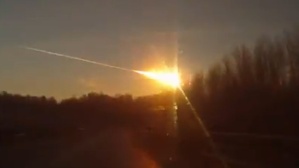Blog Archives
Meteor Streaks Over The Skies of Central Russia Causing Damage and Injuries
 showered fireballs over a large expanse while causing aerial explosions that damaged buildings, shattered windows and injured 1,200 people. The Interior Ministry said that the meteorite explosions are a very rare spectacle, it also unleashed a sonic boom.
showered fireballs over a large expanse while causing aerial explosions that damaged buildings, shattered windows and injured 1,200 people. The Interior Ministry said that the meteorite explosions are a very rare spectacle, it also unleashed a sonic boom.Heat, Fires and a Summer for Weather Records to be Broken
The heat gripping the United States in a seemingly never ending fashion eased a bit this past Saturday as a cold front came through along the eastern half of the country .This has given a slight respite from the horrendous triple digit heat there. It’s a marginal silver lining, but at least temp’s will be in the low to mid 90’s in the eastern United States. Temperatures will begin to creep past the 100 degree mark in the Western states in cities like Salt Lake City, Utah by Wednesday in response to a developing high pressure over the Rockies.
Out west high pressure will continue to build in further over the week pushing the jet stream northward into southwestern Canada, allowing the heat to advance north as well. The unbearable conditions from the heat wave have unfortunately claimed 74 lives across the U.S. since it began just two weeks ago.
The hot spell caused highways to buckle in Illinois and Wisconsin, officials said. In Maryland, investigators said heat likely caused rails to kink and led a commuter train to partially derail Friday. No one was injured. Many states in the Midwest have not seen heat like this since the Dust Bowl of 1936. According to the National Oceanic and Atmospheric Association 2012 has broken well over 40,000 daily heat records nationwide. It was the countries hottest July 4th since recording began. Agriculture like corn and soy crops are being heavily damaged from the pressure cooking heat. Severe thunderstorms blew through over a week ago knocking out power to millions in the eastern part of the U.S. . This has only added insult to injury from the already sweltering summer.
In lakes and rivers across parched areas of the U.S., heat and lower water levels are reducing oxygen levels thereby killing fish populations by the thousands. When water becomes hypoxic or lacks oxygen these large water animal die offs can occur. Wildfires continue to burn across the western United States, including wildfires in Colorado and the Fontenelle Fire in Wyoming.
NASA says the fires have a warming effect on the atmosphere due to the increased emission of aerosols, which are suspended solid or liquid particles in the air. These particles can absorb more radiation from the sun hence causing hotter weather and poorer air quality in the form of smog. Children and the elderly are the most susceptible to these adverse weather events. Make sure to drink plenty of fluids and wear sunscreen when venturing outside.
Senior Scientist in the Climate Analysis Section at the National Center for Atmospheric Research, Dr. Kevin Trenberth talked with Judy Woodruff on PBS about the unusual warmth across North America.

